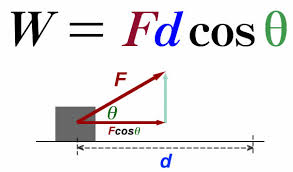Work: Difference between revisions
| Line 44: | Line 44: | ||
===A Computational Model=== | ===A Computational Model=== | ||
The work done on the system by the surrounding is dependent on the system that on decides to choose. For example, if one decides to include earth as a part of the system while calculating the different forms of energies, the work done is 0. However, if one decides to count earth as the surrounding, there is work done by earth but the potential energy from the previous case is eliminated. Glowscript below shows the calculation for the work done when modelling a spring situation while considering the earth as a surrounding. | |||
[https://trinket.io/glowscript/31d0f9ad9e Teach hands-on with GlowScript] | |||
==Examples== | ==Examples== | ||
Revision as of 21:31, 5 December 2015
The Main Idea
Work perhaps is a term that most of the people are commonly exposed to. People often use the term "work" to describe their jobs, the amount of energy they had to input to get something done, or even when they describe their gym and their routine exercise. To physicists however, work has a rather specific definition. In physics, work refers to the "efficiency" of the force. A force is doing "work" when acting upon a matter or a particle if it causes the matter to move or change in displacement.
For some people, the new rather absurd concept of work may be a bit confusing. It is important to take consider of the three so called "ingredients" when determining work. Those ingredients are the force, displacement and a cause. The force must "cause" the change in displacement in order to be doing work.
While work may seem like a simple concept, it is nonetheless extremely essential in physics calculations as it is a core aspect of a fundamental principle, the conservation of energy. This will be further discussed in the "connections" part where the individual source of energy work takes part to take role in the transfer of energy from the surrounding to a system or from the system to the surrounding to contribute to the conservation of energy.
A Mathematical Model
There are a few mathematical formulas to determine or calculate the amount of work done by the force. These formulas could be a bit different from situations to situations.
First of all, the formula for work is different according to the consistency of the force.
1) When the work is done by a constant force:
[math]\displaystyle{ W=\overrightarrow{F}\bullet\overrightarrow{dr}\cos\theta. }[/math]
It is important to note that when the direction of the force is equal to the direction of the displacement, the "theta" aspect of this equation is equal to 0, meaning that cos(0) will just be 1 and the formula can further be simplified to W = Fd.
2) When the work is done by a non-constant force:
[math]\displaystyle{ W=\int\limits_{i}^{f}\overrightarrow{F}\bullet\overrightarrow{dr} = \sum\overrightarrow{F}\bullet\Delta\overrightarrow{r} }[/math]
This might be a little easier to understand for those who have exposure to calculus. In more of simpler words, the work done by a non-constant force is the product of the summation of the forces that acts upon a system and the change in position of the system. This could be denoted by the usage of a calculus term integral; work is equal to the integral of the force in respect to change in displacement.
3) When work is done by gravity:
[math]\displaystyle{ W = F_g (y_2 - y_1) = F_g\Delta y = - mg\Delta y }[/math]
Notice that this is exact same formula as explained in number one, when the work is done by a constant force, except it is more specified. Theta was neglected because the direction of the gravitational pull was the same as change in height. Notice that this is also similar to the formula for change in potential energy, which is:
[math]\displaystyle{ \Delta PE = mg\Delta y }[/math].
From this we can conclude that:
[math]\displaystyle{ W = -\Delta PE. }[/math]
A Computational Model
The work done on the system by the surrounding is dependent on the system that on decides to choose. For example, if one decides to include earth as a part of the system while calculating the different forms of energies, the work done is 0. However, if one decides to count earth as the surrounding, there is work done by earth but the potential energy from the previous case is eliminated. Glowscript below shows the calculation for the work done when modelling a spring situation while considering the earth as a surrounding.
Teach hands-on with GlowScript
Examples
Be sure to show all steps in your solution and include diagrams whenever possible
Simple
Middling
Difficult
Connectedness
- How is this topic connected to something that you are interested in?
- How is it connected to your major?
- Is there an interesting industrial application?
History
Put this idea in historical context. Give the reader the Who, What, When, Where, and Why.
See also
Are there related topics or categories in this wiki resource for the curious reader to explore? How does this topic fit into that context?
Further reading
Books, Articles or other print media on this topic
External links
Internet resources on this topic
References
This section contains the the references you used while writing this page

